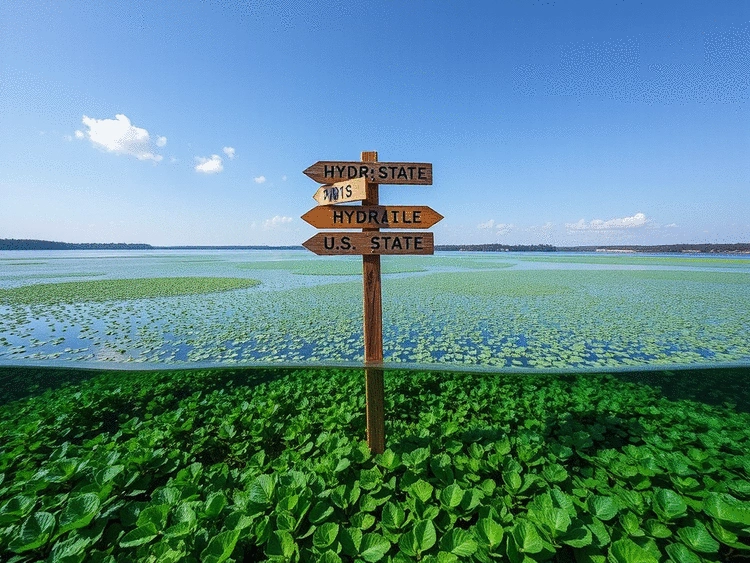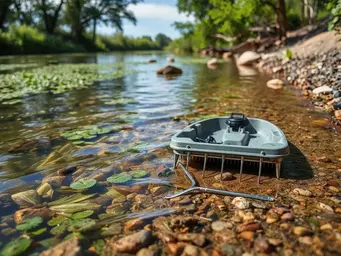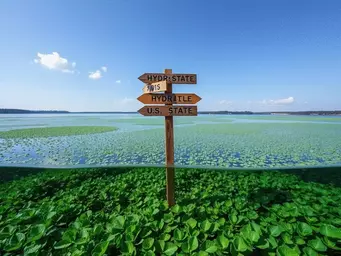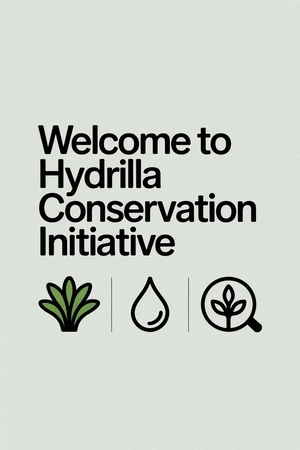Did you know that an invasive aquatic plant can grow up to an inch a day, transforming vibrant ecosystems into overrun habitats? Understanding hydrilla and its impact is crucial for effective waterway management and conservation efforts.
What You Will Learn
- Hydrilla is capable of rapid growth and can significantly disrupt local ecosystems.
- Effective management strategies require community engagement and tailored regulatory frameworks.
- Adopting innovative techniques, such as remote sensing, enhances hydrilla management efforts.
- Regular monitoring is essential to adapt management strategies and ensure ecological balance.
- Increased funding and collaborative research can strengthen state-level hydrilla control initiatives.
- Public awareness campaigns are vital for galvanizing community support for invasive species management.
Key Elements of Effective Hydrilla Management
This visual outlines the crucial components and future directions for controlling the invasive aquatic species, Hydrilla, emphasizing a multi-faceted approach to ecosystem preservation.
Understanding Hydrilla: An Invasive Aquatic Species
In the realm of aquatic ecosystems, few plants generate as much concern as hydrilla verticillata. This invasive species thrives in various waterways, often choking out native plants and disrupting local habitats. With my background as an aquatic biologist, I've seen firsthand how hydrilla can rapidly transform vibrant ecosystems into unrecognizable landscapes. Have you ever encountered a lake where the water was clear and inviting, only to find it overrun by dense patches of hydrilla?
Hydrilla's adaptability contributes to its success as an invader. It can survive in low-light conditions, reproduce quickly through fragmentation, and can even thrive in nutrient-rich environments. The consequences are dire: as hydrilla proliferates, it affects everything from fish populations to water clarity. Understanding the biology of hydrilla is essential for anyone engaged in wildlife conservation or management planning!
The Biology of Hydrilla verticillata and Its Impact on Ecosystems
Hydrilla is characterized by its unique features such as whorled leaves and robust growth patterns. Typically, its leaves are arranged in whorls of five to seven, which can make identification easier for those familiar with aquatic plants. This plant can grow at astonishing rates—up to an inch per day—creating mats that smother native vegetation and disrupt aquatic life cycles.
- Dense growth leads to decreased oxygen levels in the water.
- Fish and other wildlife lose essential habitat, impacting biodiversity.
- Water quality deteriorates, affecting recreational activities and local economies.
As we dive deeper into the specifics of hydrilla’s biology, it's critical to understand that its presence is more than just an aesthetic issue. The ecological balance is at stake, reminding us why early detection and mitigation are vital to preserving our precious waterways. What strategies can we employ to manage this invasive threat effectively?
Why Effective Hydrilla Management is Crucial for Water Quality
Addressing the challenge of hydrilla isn't just an environmental concern; it's a public health issue as well. Poor water quality that results from hydrilla overgrowth can lead to a decline in recreational opportunities and overall community well-being. As I discovered through my work with the Hydrilla Conservation Initiative at Raystown Lake, effective management is key to restoring and maintaining water quality.
- Implementing integrated management strategies can reduce hydrilla populations.
- Regular monitoring helps track the effectiveness of control efforts.
- Community engagement fosters a collective responsibility for water stewardship.
By prioritizing effective hydrilla management, we can ensure that our waterways remain vibrant ecosystems. Let’s work together to protect our native species and enhance the quality of our waters! What steps will you take to join this critical conservation effort?
Pro Tip
When managing hydrilla, consider integrating multiple control methods such as mechanical removal, herbicide application, and biological controls. This holistic approach not only targets the plant effectively but also minimizes the impact on surrounding ecosystems. Remember, a diversified strategy can lead to more sustainable outcomes in the fight against invasive species!
Key Takeaways on Hydrilla Management Policies Across States
As we have explored the various strategies states are employing to manage hydrilla, it's clear that a one-size-fits-all approach doesn't exist. Each state's policies are shaped by unique environmental conditions, regulatory frameworks, and community needs. The emphasis on local collaboration and tailored strategies is crucial for effective management. Here are some key takeaways:
- Regulatory Frameworks: Each state has developed specific regulations that guide their hydrilla management efforts, ensuring compliance and environmental protection. For instance, understanding the broader context of aquatic invasive species management, as highlighted by rapid response plans for hydrilla in Massachusetts, is essential.
- Community Engagement: Successful management strategies often involve collaboration with local stakeholders, ensuring that communities are educated and invested in the outcomes.
- Innovative Techniques: States are adopting new technologies and methods to enhance their management programs, such as remote sensing and biological control.
- Comprehensive Monitoring: Effective surveillance programs are essential for assessing the success of management strategies and adapting them as necessary.
In my experience with the Hydrilla Conservation Initiative, I’ve seen firsthand how these tailored approaches can empower local agencies and educators to tackle invasive species effectively. By focusing on the specific needs and challenges of each region, we can foster more resilient ecosystems and healthier waterways.
Future Directions: Recommendations for Improved Hydrilla Control and Legislative Action
Looking to the future, I believe there are several key areas where we can enhance hydrilla management efforts. These recommendations aim to strengthen the foundation already laid by various states:
- Increase Funding: More resources should be allocated to state-level management programs to ensure they can implement comprehensive strategies effectively.
- Enhance Research Collaboration: Encourage partnerships between universities, governmental agencies, and conservation groups to share knowledge and innovative solutions.
- Streamline Regulations: Simplifying regulatory processes can help speed up the implementation of effective control methods across states.
- Promote Public Awareness: Educational campaigns about the impacts of hydrilla and the importance of management efforts can galvanize community support and involvement.
As Dr. Clara Thorne, I advocate for these changes not only to protect our waterways but to empower communities to take action. Together, we can ensure that the fight against hydrilla evolves alongside our understanding of its impacts and control methods. It's an ongoing journey, and every effort counts!
Frequently Asked Questions About Hydrilla Management
- What is hydrilla and why is it a concern?
- Hydrilla verticillata is an invasive aquatic plant that grows rapidly, often up to an inch per day. It chokes out native plants, disrupts aquatic life cycles, decreases oxygen levels, and deteriorates water quality, affecting both ecosystems and human activities.
- How does hydrilla impact local ecosystems?
- Hydrilla's dense growth leads to decreased oxygen levels, which harms fish and other aquatic wildlife. It smothers native vegetation, reducing biodiversity, and its proliferation negatively impacts water clarity and quality, affecting recreational use and local economies.
- What are the key elements of effective hydrilla management?
- Effective management involves regulatory frameworks, community engagement, innovative techniques (such as remote sensing and biological controls), and comprehensive monitoring. Tailored strategies for local needs are crucial for success.
- What role does community engagement play in hydrilla management?
- Community engagement is vital. It fosters collective responsibility, educates residents about the problem, and encourages participation in clean-up events, workshops, and advocacy for stronger management policies and funding.
- What are the future directions for improving hydrilla control?
- Future improvements include increasing funding for state-level programs, enhancing research collaboration between various organizations, streamlining regulations to speed up control implementation, and promoting public awareness through educational campaigns.
Join the Conversation: Engaging with Local Hydrilla Management Efforts
How You Can Get Involved in Hydrilla Management and Community Restoration Projects
You might be wondering how you can contribute to the fight against hydrilla in your area. It's easier than you think! Here are some ways you can get involved:
- Volunteer for Local Clean-Up Events: Join community efforts to clear waterways of hydrilla and other debris.
- Participate in Workshops: Attend educational sessions hosted by local governments or conservation groups to learn about management strategies.
- Advocate for Policies: Engage with your local representatives to promote stronger hydrilla management policies and funding.
- Share Your Knowledge: Use social media or community forums to spread the word about the importance of managing invasive species.
Your involvement can make a significant impact! As part of the Hydrilla Conservation Initiative, I encourage each of you to take action and share your experiences. Together, we create a community dedicated to restoring our vital ecosystems.
Resources for Staying Informed About Hydrilla Policies and Management Strategies
Staying informed is key to effective participation in hydrilla management. Here are some valuable resources where you can find up-to-date information:
- Hydrilla Conservation Initiative: Visit our website for resources, identification tools, and management tutorials.
- State Environmental Agencies: Check your state’s environmental agency website for specific regulations and local management strategies.
- Community Organizations: Local conservation groups often share newsletters and updates regarding ongoing projects and volunteer opportunities.
- Research Journals: Follow scientific publications that focus on aquatic biology and invasive species management for the latest research findings.
By leveraging these resources, we can all stay informed and engaged in the ongoing challenge of managing hydrilla. It’s a shared responsibility, and your voice matters in the conversation about our ecosystems!
Recap of Key Points
Here is a quick recap of the important points discussed in the article:
- Hydrilla verticillata is an invasive aquatic species that disrupts local ecosystems and affects biodiversity.
- Understanding hydrilla's biology, including its rapid growth and adaptability, is crucial for effective management.
- Community engagement and tailored strategies are essential for successful hydrilla management across different states.
- Implementing integrated management strategies can help control hydrilla populations and restore water quality.
- Staying informed and advocating for policies can empower communities to take action against invasive species.





